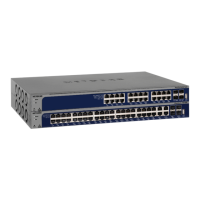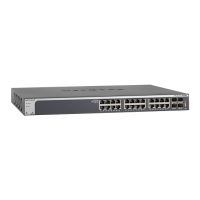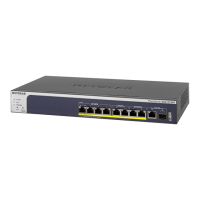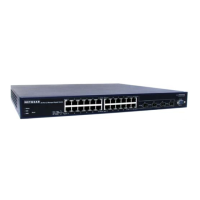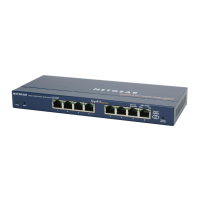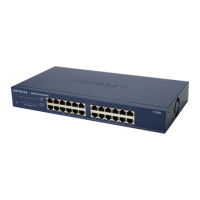Configuration Examples
428
XS708T, XS712Tv2, and XS716T Smart Managed Pro Switch User Manual
In this example, assume that Switch 1 became the root bridge for the MST instance 1, and
Switch 2 became the root bridge for MST instance 2. Switch 3 supports hosts in the sales
department (ports 1/0/1, 1/0/2, and 1/0/3) and in the HR department (ports 1/0/4 and 1/0/5).
Switches 1 and 2 also include hosts in the sales and HR departments. The hosts connected
from Switch 2 use VLAN 500, MST instance 2 to communicate with the hosts on Switch 3
directly. Likewise, hosts of Switch 1 use VLAN 300, MST instance 1 to communicate with the
hosts on Switch 3 directly.
The hosts use different instances of MSTP to effectively use the links across the switch. The
same concept can be extended to other switches and more instances of MSTP.
VLAN Routing Interface Configuration Example
VLANs divide broadcast domains in a LAN environment. When hosts in one VLAN must
communicate with hosts in another VLAN, the traffic must be routed between them. This is
known as inter-VLAN routing. On the switch, it is accomplished by creating Layer 3 interfaces
(switch virtual interfaces [SVI]).
When a port is enabled for bridging (the default) rather than routing, all normal bridge
processing is performed for an inbound packet, which is then associated with a VLAN. Its
MAC destination address (MAC DA) and VLAN ID are used to search the MAC address
table. If routing is enabled for the VLAN, and the MAC DA of an inbound unicast packet is that
of the internal bridge-router interface, the packet is routed. An inbound multicast packet is
forwarded to all ports in the VLAN, plus the internal bridge-router interface, if it was received
on a routed VLAN.
Since a port can be configured to belong to more than one VLAN, VLAN routing might be
enabled for all of the VLANs on the port, or for a subset. VLAN routing can be used to allow
more than one physical port to reside on the same subnet. It could also be used when a
VLAN spans multiple physical networks, or when additional segmentation or security is
required. A port can be either a VLAN port or a router port, but not both. However, a VLAN
port can be part of a VLAN that is itself a router port.
Complete these steps to configure a switch to perform interVLAN routing:
1. Use the IP Configuration page to enable routing on the switch.
For more information about this step, see Configure the Router IP on page 199.
2. Determine the IP addresses that you want to assign to the VLAN interface on the switch.
For the switch to be able to route between the VLANs, the VLAN interfaces must be
configured with an IP address. When the switch receives a packet destined for another
subnet/VLAN, the switch looks at the routing table to determine where to forward the
packet. The packet is then passed to the VLAN interface of the destination. It is then sent
to the port where the end device is attached.
3. Use the VLAN Routing Wizard page to create a routing VLAN, configure the IP address and
subnet mask, and add the member ports.
For more information about this step, see Use the VLAN Static Routing Wizard on
page 220.

